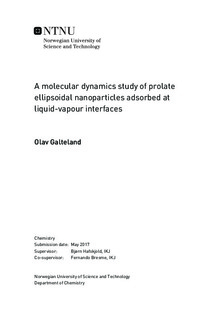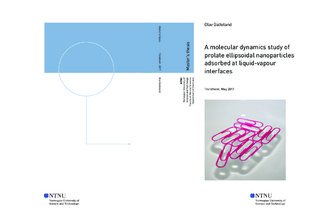| dc.description.abstract | Nanoparticles may adsorb strongly at liquid-vapour interfaces and form layers, which may be a source for new and interesting materials. It is not fully understood how the nanoparticles adsorbed at the interface interact, and how the shape and size of the nanoparticles affect the interaction. Prolate ellipsoidal nanoparticles will deform the interface, which leads to strong orientation-dependent capillary interactions. This will result in nanoparticle self-assembly.
A molecular dynamics method for modelling prolate ellipsoidal nanoparticles interacting with spherical fluid particles is described. The method was used to calculate the wetting, Brownian motion and interface deformation of nanoparticles adsorbed at liquid-vapour interfaces. The force between two nanoparticles adsorbed at an interface and two nanoparticles submerged in bulk phases was also calculated. Nanoparticle sizes ranging from approximately 0.3 nm to 5.0 nm were considered. Two different potentials have been considered for the prolate ellipsoidal nanoparticles, one with the same interaction energy all around the nanoparticle and one with higher interaction energy on the sides of the nanoparticle compared to the tip.
Highly wetting prolate ellipsoidal nanoparticles with a higher interaction energy on the sides compared to the tips were found to prefer an equilibrium orientation where the long axis of the nanoparticle is normal to the interface. The Brownian motion of prolate ellipsoidal nanoparticles suggests that they diffuse primarily along the long axis of the nanoparticle. Interface deformation of prolate ellipsoidal nanoparticles of this size was not observed. The force between nanoparticles was calculated, and used to predict the behaviour of nanoparticles adsorbed at liquid-vapour interfaces. Orientation-dependent capillary interaction between prolate ellipsoidal nanoparticles was not observed. | |

